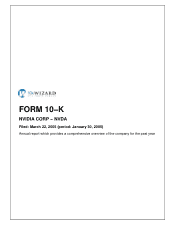NVIDIA 2005 Annual Report Download - page 9
Download and view the complete annual report
Please find page 9 of the 2005 NVIDIA annual report below. You can navigate through the pages in the report by either clicking on the pages listed below, or by using the keyword search tool below to find specific information within the annual report.
Our Products
We have three major product groups: GPUs, MCPs and WMPs. Our GPU and MCP product lines are primarily incorporated into
traditional consumer and professional computing platforms, including consumer PCs, notebook PCs, workstations, servers and video
game consoles. Our WMP product line is primarily incorporated into multimedia−rich cellular phones. Each of our product lines is
designed to provide the advanced processing of a combination of graphics and high−definition video, audio, communications,
networking security and storage. Our products are designed to support and deliver the maximum performance for the most current
standards as determined by each industry segment, and to provide a comprehensive set of features that enhance the overall operation
and compatibility of each platform they support.
GPUs. Our GPU products support desktop PCs, notebook PCs and professional workstations. We have three major families of GPUs:
GeForce, Go and NVIDIA Quadro.
GeForce. The GeForce family represents our desktop GPUs and includes the GeForce 6, GeForce FX and GeForce4 families. Our
most advanced GPU family is the GeForce 6 series. Introduced in July 2004, the GeForce 6 architecture is our second generation fully
programmable cinematic GPU and is our first GPU to support the Microsoft DirectX 9 Shader Model 3.0 standard. Our GeForce 6800
Ultra GPU is one of the semiconductor industry's most complex application specific integrated circuits, or ASICs. The GeForce 6800
Ultra GPU contains over 230 million transistors and is the industry's only mainstream GPU to incorporate 32−bit floating−point
precision. The GeForce 6800 class of GPUs is designed for the enthusiast consumer segment. In August 2004, we introduced the
GeForce 6600 GPU, which is designed for the performance consumer segment, and in October 2004, we introduced the GeForce 6200
GPU, which is designed for the mainstream consumer segment. In December 2004, we launched our GeForce 6200 GPU with
TurboCache technology. TurboCache technology is a new, patent pending hardware and software technology that we believe is
redefining the price/performance metrics for mainstream PCs. TurboCache technology allows the GPU to render directly to system
memory instead of using local frame buffer memory on the graphics card, thereby lowering on−board memory requirements and
enabling OEMs and system builders to deliver entry−level PCs with advanced GPU features and performance levels far superior to
those of integrated graphics. The GeForceFX and GeForce4 currently deliver a balance of performance and features for the
mainstream accelerated graphics port−based, or AGP−based, PC segments.
GeForce Go and NVIDIA Quadro Go. The GeForce Go and NVIDIA Quadro Go families represent our notebook GPUs and include
the GeForce 6 Go, GeForce FX Go, GeForce4 Go, NVIDIA QuadroFX Go and NVIDIA Quadro4 Go GPUs. These GPUs are
designed to deliver desktop graphics performance and features for multiple notebook configurations from desktop replacements,
multimedia notebooks and thin−and−lights to mobile workstations. The GeForce Go products are designed to serve the needs of both
corporate and consumer users. The NVIDIA Quadro Go products are designed to serve the needs of workstation professionals in the
area of product design and digital content creation.
NVIDIA Quadro. The NVIDIA Quadro branded products are robust, high−performance workstation solutions for the professional user
that are available for the high−end, mid−range, entry−level and multi−display product lines. The NVIDIA Quadro family, which
consists of the NVIDIA Quadro FX, NVIDIA Quadro4 and the NVIDIA Quadro NVS workstation solutions are designed to meet the
needs of a number of workstation applications such as industrial product design, digital content creation, non−linear video editing,
scientific and medical visualization, general purpose business and financial trading. NVIDIA Quadro products are fully certified by
several software developers for all professional workstation applications, and are designed to deliver the graphics performance and
precision required by professional applications.
Other. In addition to the production launch of the GeForce 6 family during fiscal 2005, we also introduced a number of technology
initiatives that are designed to extend the reach of our GPUs and expand the reach of the PC. We created the industry−standard mobile
PCI−Express module, or MXM, notebook GPU module, which is designed to enable faster adoption of GPUs in notebooks. We
invented scalable link interface, or SLI, which brought extreme multi−GPU graphics to enthusiasts and enabled a new class of PCs
called Gaming Supercomputers. PureVideo technology is the PC industry's first programmable video architecture and brings
consumer electronics quality video to PCs. TurboCache technology introduced the first frame buffer−less GPU, making modern GPUs
more affordable as they are burdened with less dynamic random−access memory cost. Each of these innovations are industry firsts and
have received industry−wide support and acclaim.
3






















